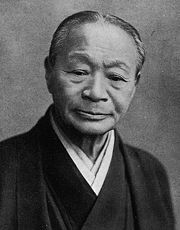- Okura Kihachiro
-
In this Japanese name, the family name is "Ōkura".
Baron Ōkura Kihachirō (大倉 喜八郎, October 23, 1837- April 5, 1928) was an entrepreneur who built up the Ōkura-gumi and founded the giant Ōkura zaibatsu (literally financial cliques) and the Ōkura Shōgyō Gakkō which later became Tokyo Keizai University in 1949.
In contrast to most of the zaibatsu, the Ōkura zaibatsu was founded by someone from the peasant class. Ōkura Kihachirō moved from what is now Niigata Prefecture on the north shore of Honshū to Edo and worked for three years before starting his own grocery store in 1857. After selling groceries for eight years, [1] he became a weapons dealer during the turbulent years between the arrival of the Black Ships and the eventual overthrow in 1867 of the Tokugawa Shogunate. He became one of the principal business investors of the original Imperial Hotel completed in 1890.[2]
Kihachiro's son, Kishichirō, is credited with introducing the automobile into Japan.
Kihachiro, who made a fortune in his lifetime and lived in Toranomon, was a collector of Oriental antiques. In fear of valuable artworks flowing out to other countries, he built Japan’s first private museum, the Ōkura Shukokan, in 1917 by donating many cultural assets he had collected, the land, and the funds. The 5-story building stood on a property of about 10,000 square meters (2.5 acres), but it was damaged in the 1923 Great Kantō earthquake. The Ōkura Shukokan that now stands adjacent to the Hotel Ōkura was rebuilt in 1928; it was based on a design by Itō Chuta, who is known for his design for Tsukiji Honganji Temple, and is designated as a cultural asset of Japan. The museum houses 2,000 pieces of Oriental paintings and sculptures, including such national treasures as the wooden statue of Samantabhadra and 35,000 volumes of Chinese literature.[3]
See also
- Ōkura Kishichirō
- Suematsu Kenchō
- Kikuchi Dairoku
- Inagaki Manjirō
- Anglo-Japanese relations
References
External links
Categories:- 1837 births
- 1928 deaths
- Japanese businesspeople
Wikimedia Foundation. 2010.

